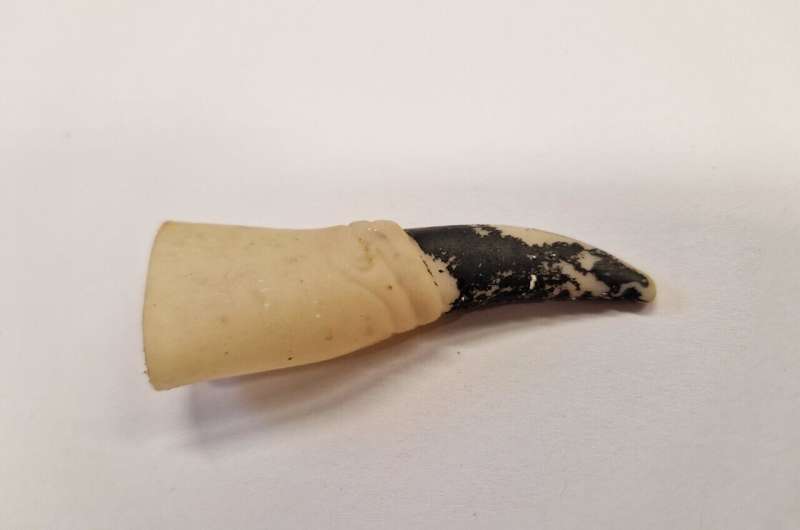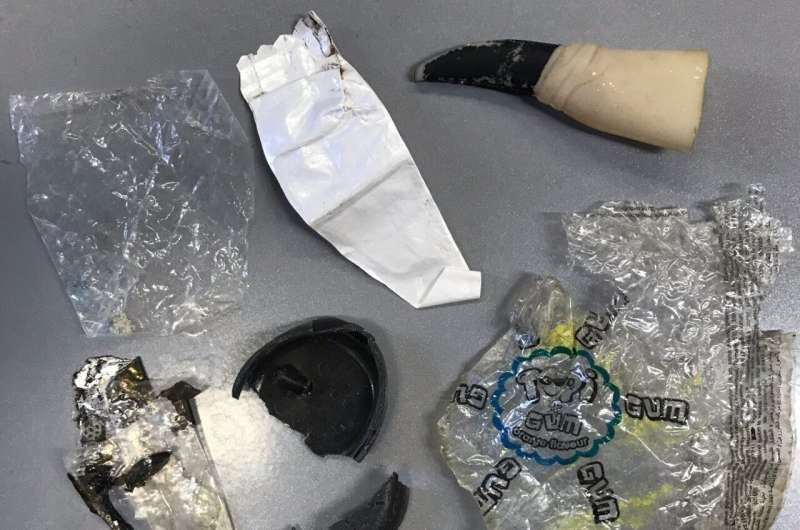This article has been reviewed according to Science X's editorial process and policies. Editors have highlighted the following attributes while ensuring the content's credibility:
fact-checked
trusted source
proofread
Halloween toy among plastics swallowed by sea turtles

A Halloween toy was among hundreds of plastic items found in the guts of dead sea turtles in the Mediterranean, a new study reveals.
Researchers examined 135 loggerhead turtles either washed up or killed as "bycatch" (accidentally caught) in fishing nets off northern Cyprus.
More than 40% of the turtles contained "macroplastics" (pieces larger than 5mm), including bottle tops and the Halloween toy—a rubber witch's finger.
The research team, led by the University of Exeter and the North Cyprus Society for the Protection of Turtles (SPOT), say loggerheads are a potential "bioindicator" species that could help them understand the scale and impact of plastic pollution.
"The journey of that Halloween toy—from a child's costume to the inside of a sea turtle—is a fascinating glimpse into the life cycle of plastic," said Dr. Emily Duncan from Centre for Ecology and Conservation on Exeter's Penryn Campus in Cornwall.
"These turtles feed on gelatinous prey such as jellyfish and seabed prey such as crustaceans, and it's easy to see how this item might have looked like a crab claw."
The study found a total of 492 macroplastic pieces, including 67 inside one turtle. It's not clear why the turtles living in the same region contained such differing levels of plastic.

Turtles showed "strong selectivity" towards certain types, colors, and shapes of plastic.
"The plastics we found were largely sheetlike (62%), clear (41%) or white (25%), and the most common polymers identified were polypropylene (37%) and polyethylene (35%)," said Dr. Duncan.
"It's likely that turtles ingest the plastics that mostly closely resemble their foods."
"We still don't know the full impacts of macroplastic on turtles' health, but negative effects could include causing blockages and limiting nutrition."
The turtles in the study were found over a 10-year period (2012-22), and incidences of macroplastic ingestion did not increase over that period but remained stable. No difference was found between stranded and bycaught turtles.
While the study provides vital information about plastic pollution in the eastern Mediterranean, more research is now needed.
"Much larger sample sizes will be needed for loggerheads to be an effective 'bioindicator' species, and we recommend studies should also include green turtles—allowing a more holistic picture to be gathered," said Professor Brendan Godley, who leads the Exeter Marine research group.
The findings are published in the journal Marine Pollution Bulletin.
More information: Emily M. Duncan et al, Marine turtles as bio-indicators of plastic pollution in the eastern Mediterranean, Marine Pollution Bulletin (2024). DOI: 10.1016/j.marpolbul.2024.116141
Provided by University of Exeter




















